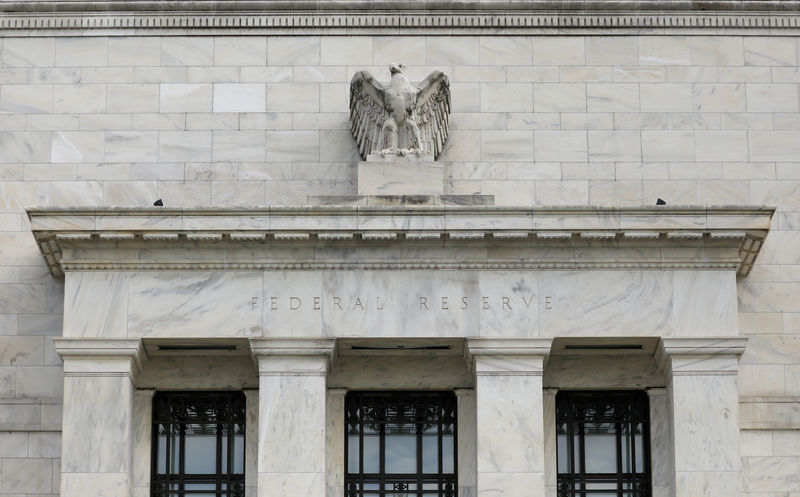By Trevor Hunnicutt and Richard Leong
(Reuters) - A small cut to an interest rate little known beyond Wall Street could lead to a big payoff for the Federal Reserve's most important asset: its credibility.
The Fed did not deliver the big-bang interest rate cut that President Donald Trump was demanding, holding firm to its view that the U.S. economy appears to be performing just fine as it is.
Instead it made what Chair Jerome Powell insisted was nothing more than a minor technical adjustment to "interest on excess reserves," or IOER, that could nudge borrowing rates lower by a few hundredths of a percentage point.
The move to change what the Fed pays banks for keeping money with the central bank is seen as critical to showing that it can still get markets to bend to its will and influence how readily banks can get cash, and in turn, make loans to corporations and consumers.
"The Fed sees this as a credibility issue," said Vincent Reinhart, chief economist at Mellon and a former Fed official.
The U.S. central bank on Wednesday left its target policy rate unchanged at 2.25-2.50% and said that the global economy warrants patience on making any further changes on rates.
But a spike since March in demand for cash in the markets where banks borrow from one another over short periods has caused the rates the Fed tries to influence to inch closer to breaching that 2.5% threshold.
So the central bank adjusted the rate it pays banks to keep money at the Fed. It said it would cut that rate on reserves to 2.35% from 2.40%.
That could cause the targeted federal funds rate to drive ever-so-slightly lower.
It is the third time since June 2018 the Fed has tweaked the difference between its target rate and the IOER and the first time the Fed has made such a move without changing the policy rate at all. It illustrates the challenges the Fed and other major central banks are encountering as they employ a variety of untested policy tools in the low-rate environment that has dominated the post-financial crisis era.
The fed funds rate rose to 2.45% on Tuesday and has remained there since, although after the Fed's announcement the rate markets expect in three months fell to 2.386% in late Wednesday trading, the lowest level since December.
Powell said in a press conference on Wednesday that the "small technical adjustment" had "no implications" for policy.
"We do think it's important that we be able to control the federal funds rate, in general, and keep it within the range," he said in response to a question from Reuters. "That's just good monetary policy - good monetary control - so we think it's important, and we have the tools to do that."
Analysts agreed, saying the tweak is also very unlikely to make any difference in the economy, or in important rates like those on mortgages, government bonds or what people earn on savings they keep at the bank.
That means the tweak is also unlikely to mollify Trump, who said on Tuesday that the economy would shoot "up like a rocket if we did some lowering of rates, like one point."
Powell also said an alternative allowing banks to trade bonds for reserves at the Fed would be discussed at future meetings.
(GRAPHIC: U.S. Federal Reserve policy rates link: https://tmsnrt.rs/2IzOkma).
FINANCIAL CRISIS
The way the Fed controls rates shifted after the 2008 financial crisis, when the central bank flooded the banking system with funds to buy bonds, lower rates and stimulate the economy.
These days it sets rates by changing what it pays banks to keep money in reserve at the Fed rather than by manipulating the amount of reserves.
Rates have been spiking in recent weeks as the central bank let some of those funds drain out of the banking system to restore policy to something closer to normal and as banks hoard reserves to meet tougher capital requirements that are also a legacy of the financial crisis.
Bank borrowing rates have also moved up because there are few big lenders in key money markets. Additionally, a decline in bank deposits as people and companies withdrew money to pay tax bills - increasing banks' need for liquidity - and banks' greater demand for funding to buy the bonds the U.S. government has been issuing to finance deficits, have pushed rates higher.
Now, by paying lenders a bit less to keep funds at the Fed, policymakers may encourage them to lend out more to other banks overnight, putting downward pressure on rates. The Fed is also putting an end to a program allowing reserves to drain out of the system later this year.
"It was the right decision," said Bill English, Professor in the Practice of Finance at the Yale School of Management, and a former Fed official. "I'm confident that they have control over short-term market rates with the tools they have."
(GRAPHIC: U.S. federal funds activity link: https://tmsnrt.rs/2EcJkRq).

(GRAPHIC: U.S. federal funds activity interactive link: https://tmsnrt.rs/2EdOEUF).